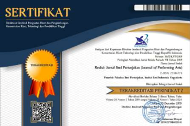Musik Metal dan Nilai Religius Islam: Tinjauan Estetika Musik Bermuatan Islami dalam Penampilan Purgatory
Abstract
Musik metal terkait dengan isu kekerasan, pemberontakan, kesewenang-wenangan. Oleh karenanya, band metal juga lekat dengan citra-citra itu. Namun demikian, Purgatory, band metal dari Jakarta, mencoba memunculkan citra yang berbeda. Mereka mengusung nilai-nilai religius islami dalam karya musik dan pertunjukannya. Dalam tulisan ini, penulis berupaya untuk memahami cara band ini tetap memiliki penggemar dengan isu-isu yang diusung tersebut. Penelitian ini menggunakan pendekatan etnografi. Pengumpulan data dilakukan dengan cara observasi-partisipasi. Penulis mengikuti dalam peristiwa-persitiwa pementasan musik metal dan juga berbagai aktivitas yang mengelilinginya. Berdasarkan penelitian dapat disimpulkan bahwa ada tiga dimensi persepsi estetika yaitu mengusung nilai-nilai religius Islami, memiliki kekhasan yang menampilkan ciri musik metal, dan mensyiarkan nilai-nilai kebaikan yang mendorong Mogerz, yakni para penggemar Purgatory tetap tertarik dengan band itu dan musiknya.
Metal Music and Islamic Religious Values: The Aesthetics Review of Islamic Music in Purgatory Performance. Metal music is closely related to violence, rebellion, and abuse. Therefore, the metal band is also associated with those images. Purgatory, a metal band in Jakarta, however, is trying to establish a distinctive image to those of metal bands in common. They are to promote Islamic religious values in their music and performances. In this paper, the writers seek to understand how this band remains having their fans with these issues. This study uses an ethnographic approach. Data collection is carried out by doing the participatory observation. The writers actively got involved in the metal music performances and also other various activities. Based on the research results, it can be concluded that there are three dimensions of the aesthetics perceptions, i.e. carrying Islamic religious values, having a characteristic that displays the characteristics of metal music, and broadcasting good values that support Mogerz, fans of Purgatory, to keep on attracted to the band and their music.
Keywords: Islamic metal music; purgatory; mogers
Keywords
Full Text:
PDFReferences
Capper, A., & Sifre, G. (2009). Heavy Metal in Baghdad: The Story of Acrassicauda. Simon and Schuster.
Frishkopf, M. (2012). Sufi Music: The Rough Guide to Sufi Music. Asian Music, 43(1), 148–155.
George, K. M. (1998). Designs on Indonesia’s Muslim communities. The Journal of Asian Studies, 57(3), 693–713.
Harnish, D. (2003). Worlds of wayang Sasak: music, performance, and negotiations of religion and modernity. Asian Music, 34(2), 91–120.
Irawati, E. (2017). Transmisi Kelentangan dalam Masyarakat Dayak Benuaq. RESITAL: JURNAL SENI PERTUNJUKAN, 17(1).
Ishak, A. H., & Osman, M. R. (2016). A systematic literature review on Islamic values applied in quality management context. Journal of Business Ethics, 138(1), 103–112.
Jouili, J. S. (2014). Refining the Umma in the shadow of the republic: Performing arts and new Islamic audio-visual landscapes in France. Anthropological Quarterly, 1079–1104.
Laksono, K. L., Anggreni Purba, S., & Dona Hapsari, P. (2015). Musik Hip-Hop sebagai Bentuk Hybrid Culture dalam Tinjauan Estetika. RESITAL: JURNAL SENI PERTUNJUKAN, 16(2).
LeVine, M. (2008). Heavy metal Islam: Rock, resistance, and the struggle for the soul of Islam. Crown.
Saeed, M., Ahmed, Z. U., & Mukhtar, S.-M. (2001). International marketing ethics from an Islamic perspective: A value-maximization approach. Journal of Business Ethics, 32(2), 127–142.
Shaw, W. M. K. (2012). The Islam in Islamic art history: secularism and public discourse. Journal of Art Historiography, (6), 1.
Stilt, K. (2010). Ḥisba, Arts and Craft in Islam. Arabisch-Islamische Welt in Tradition und Moderne, vol. 7. JSTOR.
Von Appen, R. (2007). On the aesthetics of popular music. Music Therapy Today, 8(1), 11.
Wallach, J. (2005). Underground rock music and democratization in Indonesia. World Literature Today, 79(3), 16–20.
Weinstein, D. (2000). Heavy metal: The music and its culture. Perseus Books Group.
Weintraub, A. N. (2008). ‘Dance drills, faith spills’: Islam, body politics, and popular music in post-Suharto Indonesia. Popular Music, 27(3), 367–392.
DOI: https://doi.org/10.24821/resital.v18i3.3338
Refbacks
- There are currently no refbacks.
This work is licensed under a Creative Commons Attribution 4.0 International License.



